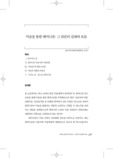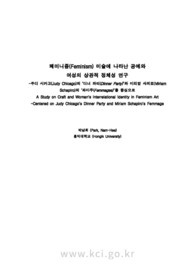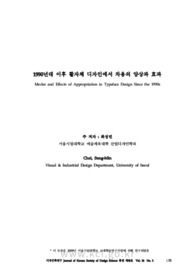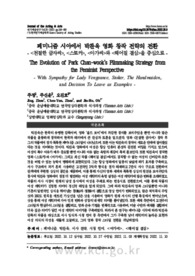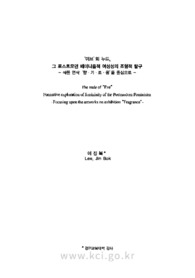

-
 * 본 문서는 배포용으로 복사 및 편집이 불가합니다.
* 본 문서는 배포용으로 복사 및 편집이 불가합니다.
미리보기
서지정보
· 발행기관 : 동아시아문화학회
· 수록지 정보 : 동아시아문화와예술
· 저자명 : 윤난지
목차
I. 들어가는 글
II. 페미니즘 미술사와 미술비평
III. ‘여성성’에 대한 논의들
IV. 미술에 재현된 여성성
Ⅴ. 나가는 글 : 포스트-페미니즘
참고문헌초록
In this essay, I would like to trace the course of feminism in art during
the last forty years through the texts on the discourse. By examining
such examples, among numerous texts, that show how feminism
has been discussed and practiced in art, I will try to render a general
topographical map of feminist discourses on art.
Examples directly showing the course, in which feminism has
been risen in art, are texts of art history or criticism that employed
feminism as their methodology. It is an attempt to restore the vision
of female subject who appreciate or interpret art -- female spectator
as well as female art historian or critic. Feminist art historians or
critics have aimed to reveal the fact that the preexisting art history has
described, far from being objective, neutral and thus universally valid,
from the male-dominated viewpoint and reproduced the patriarchal
ideology, and to correct the partial vision.
Like this, feminism has brought about changes of the vision in art
history and criticism, and thereby the methodological diversion. It has
not simply allowed female art historians and critics to join in the field,
but also paid attention, accepted and encouraged other perspective
and its own way of writing. In this sense, feminism art history and
criticism are a sort of meta-history and a meta-critics each.
The topic of feminism is above all the ‘femininity’. Arguments
on the femininity have clashed mainly on the dispute whether there
is an 'essence' of it or not, which leaded to the controversy between
the essentialism and the constructionism. The essentialism takes
a position that there is an unique femininity unpolluted with the
patriarchy and this natural essence determines the social custom. On
the contrary, the constructionism denies the existence of the 'essence'
by defining it as a social construction. So the object of the essentialists
analysis is the natural born essence of the female while the ones of
the constructionists are the social custom that made the signs of the
essence and the system of representation.
In the early years, feminists have devoted themselves to the
essentialism, convincing that there is a feminine sensibility, and have
been leaded into a secessionism with the essentialist methodology. But
the feminists of the after generations take the constructionist viewpoint
considering the femininity to be constructed on the social context. Still
they, too, have recognized the existence of the gender difference as the
constructed on the course of change, and have focused on observing
the process of the construction. In the end, on the existence of the
specific tendency of the femininity, the constructionists have something
in common with the essentialists.
In short, the 'difference' between the feminine and the femininity
(the male and the maleness) is their common starting point. And
among others, french feminists who tried to explain it through
the psychology has been noticed as so-called “feminism of the
difference”. They specially focus on the maternal body, and find the
femininity in its ‘in-between-ness’, the flexibility and the capacity
resulted from it: its specific character of ceaseless escaping from the
identification. It is a challenge and an alternative to the femininity
defined by the phallus-centric psychology of Freud and Lacan. They
are the essentialists and thus the targets of the constructionists.
However, the dichotomy is being destructed with the recent
appearance of arguments that the essentialism and the constructionism
are in contact. Besides, various branches of the essentialism are now
supported as valid practically as well as theoretically. Evoking that
there can be no feminism if the ‘femininity’ is not presupposed, they
propose rather to use the ‘essence’ strategically than to blame the
dangerous of it.
‘Femininity’ in art appears differently according to the sex of the
artist. In the major history of art, which is in fact a history of male art,
has been represented mainly by male artists. The kind of femininity
represented here is the one more of the object than the subject, that
is the one viewed by the male. On the other hand, the femininity in
works of the female artists is the representation of themselves as the
female subject.
Like this, femininity represented different after the sex of the
artist is the main topic of the feminist art historians and critics. They
question on the male-dominated aspects within it, or present the
possibility of the new history of art. The femininity within the works of
females are found and lively reassessed not only in the female imagery
but also in the unique techniques and materials like embroidery and
quilt. This offers a decisive moment for writing a new history of art
and forming a new critical discourses.
Recently feminism appears in a new version, encountering the
postmodern discourses of destruction. Different branches of feminism
putting the accent on different points like area, class, or race coexist,
as the hegemony of the major feminism gets to be criticised. The point
of issue spreads itself into every subjects including the female one,
questioning every kind of center and border. This is a symptom of the
posthuman era demonstrating that the concept of modern human, the
total and autonomous subject has collapsed. And art is no exception
on this matter.
The process where the numerous texts has corresponded, referred
collide and compromise each other is the feminist history of art.
Revealing the sexually discriminative structure under the cultural
representations, works of art, and enlightening the critical awareness
are common to these diverse discourses.영어초록
In this essay, I would like to trace the course of feminism in art duringthe last forty years through the texts on the discourse. By examiningsuch examples, among numerous texts, that show how feminismhas been discussed and practiced in art, I will try to render a generaltopographical map of feminist discourses on art.Examples directly showing the course, in which feminism hasbeen risen in art, are texts of art history or criticism that employedfeminism as their methodology. It is an attempt to restore the visionof female subject who appreciate or interpret art -- female spectatoras well as female art historian or critic. Feminist art historians orcritics have aimed to reveal the fact that the preexisting art history hasdescribed, far from being objective, neutral and thus universally valid,from the male-dominated viewpoint and reproduced the patriarchalideology, and to correct the partial vision.Like this, feminism has brought about changes of the vision in arthistory and criticism, and thereby the methodological diversion. It hasnot simply allowed female art historians and critics to join in the field,but also paid attention, accepted and encouraged other perspectiveand its own way of writing. In this sense, feminism art history andcriticism are a sort of meta-history and a meta-critics each.The topic of feminism is above all the ‘femininity’. Argumentson the femininity have clashed mainly on the dispute whether thereis an 'essence' of it or not, which leaded to the controversy betweenthe essentialism and the constructionism. The essentialism takesa position that there is an unique femininity unpolluted with thepatriarchy and this natural essence determines the social custom. Onthe contrary, the constructionism denies the existence of the 'essence'by defining it as a social construction. So the object of the essentialistsanalysis is the natural born essence of the female while the ones ofthe constructionists are the social custom that made the signs of theessence and the system of representation.In the early years, feminists have devoted themselves to theessentialism, convincing that there is a feminine sensibility, and havebeen leaded into a secessionism with the essentialist methodology. Butthe feminists of the after generations take the constructionist viewpointconsidering the femininity to be constructed on the social context. Stillthey, too, have recognized the existence of the gender difference as theconstructed on the course of change, and have focused on observingthe process of the construction. In the end, on the existence of thespecific tendency of the femininity, the constructionists have somethingin common with the essentialists.In short, the 'difference' between the feminine and the femininity(the male and the maleness) is their common starting point. Andamong others, french feminists who tried to explain it throughthe psychology has been noticed as so-called “feminism of thedifference”. They specially focus on the maternal body, and find thefemininity in its ‘in-between-ness’, the flexibility and the capacityresulted from it: its specific character of ceaseless escaping from theidentification. It is a challenge and an alternative to the femininitydefined by the phallus-centric psychology of Freud and Lacan. Theyare the essentialists and thus the targets of the constructionists.However, the dichotomy is being destructed with the recentappearance of arguments that the essentialism and the constructionismare in contact. Besides, various branches of the essentialism are nowsupported as valid practically as well as theoretically. Evoking thatthere can be no feminism if the ‘femininity’ is not presupposed, theypropose rather to use the ‘essence’ strategically than to blame thedangerous of it.‘Femininity’ in art appears differently according to the sex of theartist. In the major history of art, which is in fact a history of male art,has been represented mainly by male artists. The kind of femininityrepresented here is the one more of the object than the subject, thatis the one viewed by the male. On the other hand, the femininity inworks of the female artists is the representation of themselves as thefemale subject.Like this, femininity represented different after the sex of theartist is the main topic of the feminist art historians and critics. Theyquestion on the male-dominated aspects within it, or present thepossibility of the new history of art. The femininity within the works offemales are found and lively reassessed not only in the female imagerybut also in the unique techniques and materials like embroidery andquilt. This offers a decisive moment for writing a new history of artand forming a new critical discourses.Recently feminism appears in a new version, encountering thepostmodern discourses of destruction. Different branches of feminismputting the accent on different points like area, class, or race coexist,as the hegemony of the major feminism gets to be criticised. The pointof issue spreads itself into every subjects including the female one,questioning every kind of center and border. This is a symptom of theposthuman era demonstrating that the concept of modern human, thetotal and autonomous subject has collapsed. And art is no exceptionon this matter.The process where the numerous texts has corresponded, referredcollide and compromise each other is the feminist history of art.Revealing the sexually discriminative structure under the culturalrepresentations, works of art, and enlightening the critical awarenessare common to these diverse discourses.참고자료
· 없음태그
-
자료후기
Ai 리뷰지식판매자가 제공한 자료는 정보가 풍부하고, 내용이 명확하게 정리되어 있어 과제를 작성하는데 큰 도움이 되었습니다. 매우 추천할 만한 자료입니다! -
자주묻는질문의 답변을 확인해 주세요

꼭 알아주세요
-
본 학술논문은 (주)학지사와 각 학회간에 저작권계약이 체결된 것으로 AgentSoft가 제공 하고 있습니다.
본 저작물을 불법적으로 이용시는 법적인 제재가 가해질 수 있습니다. -
해피캠퍼스는 구매자와 판매자 모두가 만족하는 서비스가 되도록 노력하고 있으며, 아래의 4가지 자료환불 조건을 꼭 확인해주시기 바랍니다.
파일오류 중복자료 저작권 없음 설명과 실제 내용 불일치 파일의 다운로드가 제대로 되지 않거나 파일형식에 맞는 프로그램으로 정상 작동하지 않는 경우 다른 자료와 70% 이상 내용이 일치하는 경우 (중복임을 확인할 수 있는 근거 필요함) 인터넷의 다른 사이트, 연구기관, 학교, 서적 등의 자료를 도용한 경우 자료의 설명과 실제 자료의 내용이 일치하지 않는 경우
찾으시던 자료가 아닌가요?
지금 보는 자료와 연관되어 있어요!
문서 초안을 생성해주는 EasyAI
